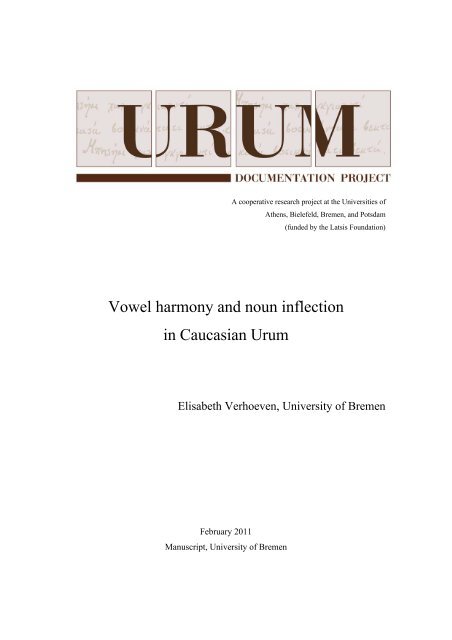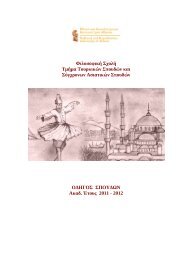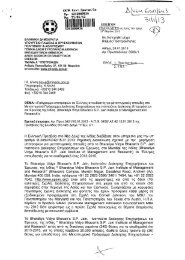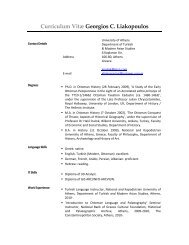Vowel harmony and noun inflection in Caucasian Urum
Vowel harmony and noun inflection in Caucasian Urum
Vowel harmony and noun inflection in Caucasian Urum
Create successful ePaper yourself
Turn your PDF publications into a flip-book with our unique Google optimized e-Paper software.
A cooperative research project at the Universities ofAthens, Bielefeld, Bremen, <strong>and</strong> Potsdam(funded by the Latsis Foundation)<strong>Vowel</strong> <strong>harmony</strong> <strong>and</strong> <strong>noun</strong> <strong><strong>in</strong>flection</strong><strong>in</strong> <strong>Caucasian</strong> <strong>Urum</strong>Elisabeth Verhoeven, University of BremenFebruary 2011Manuscript, University of Bremen
AbstractThis article is a study of vowel <strong>harmony</strong> with<strong>in</strong> the nom<strong>in</strong>al <strong><strong>in</strong>flection</strong>al system of<strong>Caucasian</strong> <strong>Urum</strong>, a Turkish variety spoken by ethnic Greek speakers <strong>in</strong> Georgia.Empirical evidence comes from an elicitation study <strong>in</strong>clud<strong>in</strong>g repeated observations witheight native speakers of <strong>Urum</strong>. A comparison with the contemporary st<strong>and</strong>ard Turkishsystem <strong>in</strong> the same grammatical doma<strong>in</strong> reveals that part of the systems is identical <strong>in</strong>both languages, namely vowel <strong>harmony</strong> with so-called A-type suffixes. However, <strong>in</strong>contrast to st<strong>and</strong>ard Turkish, some <strong>Urum</strong> nom<strong>in</strong>al suffixes (belong<strong>in</strong>g to the I-type) arepartially opaque, others are completely opaque to <strong>harmony</strong> rules. Based on evidence fromcomplex cases of suffixation we argue that opacity appears on the right edge of the<strong>harmony</strong> span, i.e., applies with priority to the rightmost suffixes of a word.1. IntroductionThis article presents data from <strong>Caucasian</strong> <strong>Urum</strong>, a variety of Turkish spoken by ethnicGreek speakers <strong>in</strong> Georgia. We observe part of the system of vowel <strong>harmony</strong>, namelyharmonic rules <strong>in</strong> nom<strong>in</strong>al <strong><strong>in</strong>flection</strong>, <strong>and</strong> compare it with the Turkish <strong>harmony</strong> system <strong>in</strong>the same grammatical doma<strong>in</strong>. In particular, we are go<strong>in</strong>g to present evidence from anelicitation study that was carried out with eight native speakers orig<strong>in</strong>at<strong>in</strong>g from theTsalka region <strong>in</strong> Georgia.<strong>Urum</strong> is the name of a Turkic variety spoken by ethnic Greek speakers <strong>in</strong> the CrimeanPen<strong>in</strong>sula (Ucra<strong>in</strong>e) <strong>and</strong> the Caucasus (Georgia). The language is very poorlydocumented <strong>and</strong> nowadays strongly endangered. Previous literature assumes that <strong>Urum</strong>developed from the Crimean Tatar language to which a subgroup of Crimean Greeksswitched <strong>in</strong> the 18 th century (see Podolsky 1986). At the same time, it is supposed that<strong>Caucasian</strong> <strong>Urum</strong> <strong>and</strong> Crimean <strong>Urum</strong> are varieties of the same language (see Podolsky1986: 100). Both populations share <strong>in</strong> common that they are ethnic Greek <strong>and</strong> speak aTurkic language. However, historical evidence about the history of these two populationsshows that they do not immediately relate to each other. Crimean <strong>Urum</strong> speakersorig<strong>in</strong>ate <strong>in</strong> the Crimean Greek population that switched to the local Tatar language aftercontact with Crimean Tatars <strong>in</strong> the 18 th century. <strong>Caucasian</strong> <strong>Urum</strong> speakers came to the
Caucasus from Anatolia, <strong>in</strong> particular from Kars, <strong>in</strong> the course of resettlements dur<strong>in</strong>g thebeg<strong>in</strong>n<strong>in</strong>g of 19 th century – <strong>and</strong> do not have any immediate historical l<strong>in</strong>ks to the CrimeanGreek population. They had probably switched to Turkish <strong>in</strong> a time prior to theirresettlement on the Caucasus <strong>and</strong> their language developed <strong>in</strong> contact to the otherlanguages of the region, most importantly Armenian, Georgian, <strong>and</strong> – <strong>in</strong> the 20 th century– Russian.The misunderst<strong>and</strong><strong>in</strong>g concern<strong>in</strong>g the language identity <strong>in</strong> the previous literature isprobably due to the fact that both groups refer to themselves with the same ethnonym‘<strong>Urum</strong>’, which orig<strong>in</strong>ates from the medieval ethnonym Rōmiós used for citizens of theByzant<strong>in</strong>e (Eastern Roman) Empire <strong>and</strong> to the fact that the available <strong>in</strong>formation aboutthe l<strong>in</strong>guistic properties of both languages is extremely poor. 1Today, <strong>Caucasian</strong> <strong>Urum</strong> is heavily endangered as is evidenced by the rapid decl<strong>in</strong>e ofnumbers of speakers liv<strong>in</strong>g <strong>in</strong> the Tsalka district of Georgia, about 100 km Southeast ofTbilisi. Accord<strong>in</strong>g to Wheatley 2006 the number of <strong>Urum</strong> speakers of Tsalka decreasedfrom 30811 <strong>in</strong> 1979 (follow<strong>in</strong>g the census of the Georgian SSR) to an estimatedpopulation of 1500 speakers <strong>in</strong> 2006. This rapid decl<strong>in</strong>e is also due to the fact that a greatmajority of the speakers left the region migrat<strong>in</strong>g to Tbilisi or to Greece.The data presented <strong>in</strong> this article come from the <strong>Caucasian</strong> variety of <strong>Urum</strong>, spoken <strong>in</strong> theTsalka district of Georgia. They were collected through <strong>in</strong>terviews with native speakersorig<strong>in</strong>at<strong>in</strong>g from Tsalka who lived <strong>in</strong> Tbilisi by the time of the <strong>in</strong>terviews <strong>in</strong> September2009. In particular, we exam<strong>in</strong>e data concern<strong>in</strong>g vowel <strong>harmony</strong> <strong>in</strong> <strong>Urum</strong>. As manyTurkic languages, <strong>Caucasian</strong> <strong>Urum</strong> displays rules of vowel <strong>harmony</strong> which affect thewhole derivational <strong>and</strong> <strong><strong>in</strong>flection</strong>al morphology of the language. In this article, weconcentrate on the <strong><strong>in</strong>flection</strong>al morphology of the <strong>noun</strong> <strong>and</strong> show <strong>in</strong> how far it deviatesfrom contemporary st<strong>and</strong>ard Turkish (as described <strong>in</strong> reference grammars such asKornfilt 1997 <strong>and</strong> Göksel & Kerslake 2005). An expansion of the study is planned whichexam<strong>in</strong>es the phenomena under <strong>in</strong>vestigation <strong>in</strong> the Anatolian variety of Turkish of theKars region, i.e. the region where the ancestors of the <strong>Caucasian</strong> <strong>Urum</strong> speakers orig<strong>in</strong>ate1 The u- is prosthetic s<strong>in</strong>ce Turkic languages orig<strong>in</strong>ally did not have r <strong>in</strong> word-<strong>in</strong>itial position (see Podolsky1986: 100).
from. This is to clarify <strong>in</strong> how far the <strong>Urum</strong> facts are identical or similar to the orig<strong>in</strong>alTurkish variety the speakers had at their disposal when emigrat<strong>in</strong>g to the Causacus orwhether there are changes as a result of an <strong>in</strong>dependent development <strong>in</strong> a differentl<strong>in</strong>guistic environment.2. Prelim<strong>in</strong>aries: <strong>Vowel</strong> Harmony<strong>Vowel</strong> <strong>harmony</strong> describes the phenomenon of spread<strong>in</strong>g of a phonological feature of thevowel system to all the vowels with<strong>in</strong> the word doma<strong>in</strong> (see Chomsky <strong>and</strong> Halle 1968,Kaun 1995, Steriade 1995). Altaic languages show different patterns of vowel <strong>harmony</strong>(see Vago 1973 for an overview).3. <strong>Vowel</strong> <strong>harmony</strong> <strong>in</strong> TurkishTurkish shows two types of vowel <strong>harmony</strong> (see Göksel & Kerslake 2005, sect. 3): a<strong>harmony</strong> concern<strong>in</strong>g the front-back-axis (often called either front<strong>in</strong>g or backness<strong>harmony</strong>) <strong>and</strong> a so-called round<strong>in</strong>g <strong>harmony</strong>, harmoniz<strong>in</strong>g the vowels based on thefeature [+/- rounded]. <strong>Vowel</strong> <strong>harmony</strong> rules apply to two different types of suffixes, socalledA-type suffixes, bear<strong>in</strong>g the features [-rounded], [-high], <strong>and</strong> so-called I-typesuffixes, bear<strong>in</strong>g the feature [+high]. The plural suffix -lAr <strong>and</strong> the case suffixes -(y)A‘DAT’, -DA ‘LOC’, <strong>and</strong> -DAn ‘ABL’ belong to the A-type suffixes. The case suffixes -(y)I‘ACC’ <strong>and</strong> -(n)In ‘GEN’ <strong>and</strong> the 3 rd person possessive suffix -(s)I(n) belong to the I-typesuffixes.Table 1 gives an overview of both types of <strong>harmony</strong>. A-type suffixes are realized as /e/follow<strong>in</strong>g syllables with the front vowels /i/, /e/, /ü/, <strong>and</strong> /ö/. They are realized as /a/follow<strong>in</strong>g the back vowels /ı/, /a/, /u/, <strong>and</strong> /o/. I-type suffixes harmonize not onlyaccord<strong>in</strong>g to the position on the front-back-axis, but additionally to the roundedness valueof a preced<strong>in</strong>g syllable, as <strong>in</strong>dicated <strong>in</strong> Table 1. Thus, the front unrounded vowels /i/ <strong>and</strong>/e/ are followed by /i/ <strong>and</strong> the front rounded vowels /ü/ <strong>and</strong> /ö/ are followed by /ü/. Theback unrounded vowels /ı/ <strong>and</strong> /a/ are followed by /ı/ <strong>and</strong> the back rounded vowels /u/<strong>and</strong> /o/ are followed by /u/. Example (1a) illustrates front<strong>in</strong>g <strong>harmony</strong> with the A-type
plural suffix -lAr. Example (1b) illustrates front<strong>in</strong>g <strong>and</strong> round<strong>in</strong>g <strong>harmony</strong> with the I-type accusative suffix -(y)I.Table 1. Turkish vowel <strong>harmony</strong>front –round +high i–high e+round +high ü–high öback –round +high ı–high a+round +high u–high o/I/iüıu/A/ea(1) Turkisha. ev-ler ‘house-PL’, çocuk-lar ‘child PL’ (Göksel & Kerslake 2005:68)b. ev-i ‘house-ACC, saray-ı ‘palace- ACC’, su-yu ‘water- ACC’, küçüğ-ü‘small- ACC’ (Göksel & Kerslake 2005:69/70)4. <strong>Caucasian</strong> <strong>Urum</strong> data4.1. Prelim<strong>in</strong>ary observationsAt the beg<strong>in</strong>n<strong>in</strong>g of our study we observed that <strong>Urum</strong> differed from Turkish concern<strong>in</strong>gsome <strong>harmony</strong> rules while other rules seemed to be identical. E.g. the A-type suffixessuch as the case suffixes for dative -(y)A, locative -DA, <strong>and</strong> ablative -DAn, as well as theplural suffix -lAr behaved <strong>in</strong> <strong>Urum</strong> as known from Turkish (see (2a) <strong>and</strong> the respectivecases <strong>in</strong> Table 2.(2) <strong>Caucasian</strong> <strong>Urum</strong> <strong>and</strong> Turkish (Göksel & Kerslake 2005:69/70)ev-ler ‘house-PL’, ev-e ‘house-DAT’, ev-de ‘house-LOC’, ev-den ‘house-ABL’Table 2. Turkish <strong>and</strong> <strong>Urum</strong> case paradigms of ev ‘house’ <strong>and</strong> kız ‘girl’
4.2. Elicitation studyAn elicitation study was implemented <strong>in</strong> a repeated-observations design. It was the aim ofthe study is to draw conclusions on the properties of the <strong>Urum</strong> suffixes <strong>in</strong> nom<strong>in</strong>al<strong><strong>in</strong>flection</strong>. The task was to translate sentences from Russian to <strong>Urum</strong>. Eight nativespeakers of <strong>Urum</strong> who were bil<strong>in</strong>gual with Russian participated <strong>in</strong> the study (female 6,age range: 22-73, average: 57.1) <strong>in</strong> September 2009 <strong>in</strong> Tbilisi. The study was carried outby Violeta Moisieva who presented the Russian sentences orally <strong>and</strong> noted down the<strong>Urum</strong> translations given by the participants.The questionnaire presented to the participants conta<strong>in</strong>ed 96 Russian sentences. Eachsentence was <strong>in</strong>tended to elicitate an <strong>Urum</strong> target word as an <strong>in</strong>stance of a word type witha given phonological shape. An <strong>in</strong>vestigation of vowel <strong>harmony</strong> <strong>in</strong> <strong>Urum</strong> nom<strong>in</strong>almorphology has to consider the phonological conditions of eight possible vowel qualities<strong>in</strong> <strong>noun</strong> roots, as <strong>in</strong>dicated <strong>in</strong> Table 3.Table 3. Phonological conditions of the <strong>noun</strong> bases with example itemsitem 1 item 2front –round +high i it ‘dog’ pisik ‘cat’–high e ev ‘house’ eshek ‘donkey’+round +high ü üzüg ‘r<strong>in</strong>g’ dügyün ‘wedd<strong>in</strong>g’–high ö göl ‘lake’ köv ‘village’back –round +high ı ġız ‘girl’ ġapı ‘door’–high a at ‘horse’ shar ‘city’+round +high u donguz ‘pig’ ġush ‘bird’–high o yol ‘road’ horoz ‘cock’Two lexical items per phonological condition were chosen as listed <strong>in</strong> Table 3. Each ofthese items was elicited through the translations <strong>in</strong> six <strong>in</strong>flected forms. These areenumerated <strong>and</strong> exemplified <strong>in</strong> (5). (5a-c) presents those cases where one suffix is addedto a <strong>noun</strong> stem, namely the genitive suffix -(n)In, the 3 rd person possessive suffix -(s)I(n),<strong>and</strong> the plural suffix -lAr. In (5d-g) two suffixes occur concatenated, namely the plural<strong>and</strong> the genitive suffixes -lAr-In, the plural <strong>and</strong> the 3 rd person possessive suffixes -lAr-I(n), <strong>and</strong> the 3 rd person possessive <strong>and</strong> the genitive suffixes -(s)In-In.
(5) Conditions of morphological form of the suffix(a)(b)(c)(d)(e)(f)GENThe old dog's name is beautiful.3.SG.POSSMaria’s dog is beautiful.PLThese black dogs are beautiful.PL-GENThe old dogs' hair is beautiful.PL-3.SG.POSSMaria’s dogs are beautiful.3.SG.POSS-GENThe name of Maria’s dog is beautiful.The 16 lexical items listed <strong>in</strong> Table 3 were presented <strong>in</strong> the 6 morpho-syntacticconditions given <strong>in</strong> (5) result<strong>in</strong>g <strong>in</strong> 96 sentences for translation. Each speaker translatedall 96 sentences that were presented <strong>in</strong> eight different r<strong>and</strong>omizations. Thus, the result<strong>in</strong>gdata conta<strong>in</strong>s two observations per speaker for each phonological condition. No fillerswere <strong>in</strong>cluded <strong>in</strong> the study s<strong>in</strong>ce the target of observation is completely non-visible to thespeakers. The duration of one elicitation session was around 60 m<strong>in</strong>utes.5. Results5.1. Valid dataGiven the experimental task, the produced translations were <strong>in</strong>cluded <strong>in</strong> the valid data setif they conta<strong>in</strong>ed the <strong>in</strong>tended target word with the <strong>in</strong>tended <strong><strong>in</strong>flection</strong>al suffix(es) foreach grammatical condition. Hence, sentences <strong>in</strong> which the speaker chose another itemthan the <strong>in</strong>tended word as a translation equivalent (which usually had a differentphonological shape) were identified as non-valid. Furthermore, we excluded cases wherethe speakers added <strong><strong>in</strong>flection</strong>al material or left out <strong>in</strong>tended suffixes <strong>in</strong> the target words.
For <strong>in</strong>stance, occasionally speakers added the plural suffix –lAr (e.g. <strong>in</strong> the condition (5a)– realization of genitive or <strong>in</strong> the condition (5b) – realization of the 3 rd personpossessive), or they left it out (e.g. <strong>in</strong> the condition (5d) – realization of plural plusgenitive or <strong>in</strong> the condition (5e) – realization of plural plus 3 rd person possessive). Whilesuch cases occurred only occasionally, <strong>in</strong> the condition (5f) there was a rather highnumber of non-valid items s<strong>in</strong>ce it seems to be the case <strong>in</strong> <strong>Urum</strong> that <strong>in</strong> the sequence‘3.SG.POSS-GEN’ the possessive marker can be regularly left out (e.g. üzüg-ün ‘r<strong>in</strong>g-GEN’<strong>in</strong>stead of üzüg-ün-ün ‘r<strong>in</strong>g-3.SG.POSS-GEN’). This is also usual <strong>in</strong> <strong>in</strong>formal Turkish style.5.2. Simple suffixationIn this section the results concern<strong>in</strong>g simple suffixation of genitive suffix -(n)In, the 3 rdperson possessive suffix -(s)I(n), <strong>and</strong> the plural suffix -lAr will be presented. Figure 1shows the percentages of which vowel the speakers produced with the genitive suffixafter a given stem vowel group characterized by horizontal position <strong>and</strong> roundednessvalues. In (6) the predom<strong>in</strong>antly produced forms of the items tested are given.(6) Results: Production of genitive suffix -(s)I(n)(a) front, -roundit-ın ‘dog-GEN’, ev-ın ‘house-GEN’(b) front, +roundüzüg-ün ‘r<strong>in</strong>g-GEN’, göl-ün ‘lake-GEN’(c) back, -roundġız-ın ‘girl-GEN’, at-ın ‘horse-GEN’(d) back, +rounddonguz-un ‘pig-GEN’, yol-un ‘road-GEN’
Figure 1. <strong>Vowel</strong> quality of genitive suffix100%% of vowel choiceuıüi0%front -round(e, i)front +round(ü, ö)back -round(ı, a)back +round(o, u)The first result visible <strong>in</strong> Figure 1 is that there is a small amount of variation <strong>in</strong> three ofthe four contexts. Apart from that a rather clear picture emerges as concerns the choice ofthe vowel of the genitive suffix -(n)In. The front <strong>and</strong> back unrounded vowels tend toharmonize with /ı/ (the high back unrounded vowel). Thus, the <strong>Urum</strong> data differ from thest<strong>and</strong>ard Turkish picuture <strong>in</strong> that the front unrounded vowels /i/ <strong>and</strong> /e/ do not trigger /i/,i.e. the high front unrounded vowel). In contrast, the <strong>Urum</strong> front <strong>and</strong> back rounded stemvowels dom<strong>in</strong>antly trigger the high front <strong>and</strong> back rounded vowels respectively - as theydo <strong>in</strong> st<strong>and</strong>ard Turkish, i.e. the genitive suffixes harmonize accord<strong>in</strong>g to roundedness <strong>and</strong>the front-back-achsis. This result is presented <strong>in</strong> Table 4 <strong>in</strong> comparison to the st<strong>and</strong>ardTurkish system.Table 4. Realization of genitive suffix <strong>in</strong> <strong>Urum</strong> vs. St<strong>and</strong>ard Turkish<strong>Urum</strong> St<strong>and</strong>ard Turkishfront –round +high iıi–high e+round +high üü–high öback –round +high ıı–high a+round +high uu–high o
Summariz<strong>in</strong>g it can be stated that there is a rather clear difference between <strong>Urum</strong> <strong>and</strong>st<strong>and</strong>ard Turkish vowel <strong>harmony</strong> <strong>in</strong> the genitive suffix -(n)In concern<strong>in</strong>g the frontunrounded vowels, which pattern with the back unrounded vowels <strong>in</strong> the <strong>Urum</strong> system.The feature [+front] is opaque to the harmoniz<strong>in</strong>g rules for the unrounded vowels of thegenitive suffix. In conclusion, round<strong>in</strong>g <strong>harmony</strong> is effective but front<strong>in</strong>g <strong>harmony</strong> onlyapplies to the rounded, not to the unrounded vowels.Next the results concern<strong>in</strong>g the second I-type suffix of the study, namely the 3 rd personpossessive suffix -(s)I(n), are illustrated <strong>in</strong> (7) <strong>and</strong> presented <strong>in</strong> Figure 2.(7) Results: Production 3 rd person possessive suffix -(s)I(n)(a) front, -roundit-i ‘dog-3.SG.POSS’, ev-i ‘house-3.SG.POSS’(b) front, +roundüzüg-i ‘r<strong>in</strong>g-3.SG.POSS’, göl-i ‘lake-3.SG.POSS’(c) back, -roundġız-i ‘girl-SG.POSS’, at-i ‘horse-3.SG.POSS’(d) back, +rounddonguz-i ‘pig-3.SG.POSS’, yol-i ‘road-SG.POSS’Figure 2. <strong>Vowel</strong> quality of 3 rd person possessive suffix100%i% of vowel choicei0%front -round(e, i)front +round(ü, ö)back -round(ı, a)back +round(o, u)The results <strong>in</strong> Figure 2 are very clear <strong>and</strong> no variation is attested. The <strong>Urum</strong> 3 rd personpossessive suffix is <strong>in</strong>variably /i/. No <strong>harmony</strong> process applies, the suffix is frozen <strong>and</strong>
opaque to vowel <strong>harmony</strong>. The difference to st<strong>and</strong>ard Turkish is illustrated <strong>in</strong> Table 5. Aswill become apparent further down <strong>in</strong> Section 5.3, the opacity to vowel <strong>harmony</strong> of the<strong>Urum</strong> 3 rd person possessive suffix only applies <strong>in</strong> word-f<strong>in</strong>al position (<strong>in</strong> an opensyllable). It seems very probable that the <strong>Caucasian</strong> <strong>Urum</strong> realization of the 3 rd personpossessive suffix can be related to the Turkish dialect of the speakers’ ancestors. Notethat <strong>in</strong> Old Turkic the possessive suffix –(s)i was <strong>in</strong>variable (see Johanson 1998:108,Anderson 1996). Dialects of the Trabzon area seem to have preserved archaic stages of<strong>harmony</strong> rules <strong>in</strong>clud<strong>in</strong>g the encod<strong>in</strong>g of the 3 rd person possessive <strong>and</strong> the accusative bymeans of /i/ (see examples <strong>in</strong> Brendemoen 1998:239). Evidence for variable <strong>and</strong> different<strong>harmony</strong> rules <strong>in</strong> comparison to contemporary st<strong>and</strong>ard Turkish can be found for EasternTurkish (Brockelmann 1954) <strong>and</strong> Ottoman Turkish (Kerslake 1998).Table 5. Realization of 3 rd person possessive suffix <strong>in</strong> <strong>Urum</strong> vs. St<strong>and</strong>ard Turkish<strong>Urum</strong> St<strong>and</strong>ard Turkishfront –round +high ii–high e+round +high üü–high öiback –round +high ıı–high a+round +high uu–high oF<strong>in</strong>ally we turn to the plural suffix -lAr <strong>and</strong> its realization <strong>in</strong> our elicitation study. Figure3 presents the results while (8) illustrates the prevail<strong>in</strong>g realization for each phonologicalcondition.(8) Results: Production plural suffix -lAr(a) front, -roundit-ler ‘dog-PL’, ev-ler ‘house-PL’(b) front, +roundüzüg-ler ‘r<strong>in</strong>g-PL’, göl-ler ‘lake-PL’
(c)(d)back, -roundġız-lar ‘girl-PL’, at-lar ‘horse-PL’back, +rounddonguz-lar ‘pig-PL’, yol-lar ‘road-PL’Figure 3. <strong>Vowel</strong> quality of the plural suffix100%% of vowel choiceea0%front -round(e, i)front +round(ü, ö)back -round(ı, a)back +round(o, u)The experimental results confirm the prelim<strong>in</strong>ary impression expressed <strong>in</strong> Section 4.1that <strong>harmony</strong> concern<strong>in</strong>g A-type suffixes is <strong>in</strong>tact <strong>in</strong> <strong>Caucasian</strong> <strong>Urum</strong>. Plural mark<strong>in</strong>g <strong>in</strong><strong>Urum</strong> follows the front<strong>in</strong>g <strong>harmony</strong> as does plural mark<strong>in</strong>g <strong>in</strong> st<strong>and</strong>ard Turkish.5.3. Suffix concatenationIn this section effects of suffix concatenation <strong>in</strong> our study will be presented <strong>and</strong>discussed. We will observe the cases <strong>in</strong>troduced <strong>in</strong> (5d-g) above, namely theconcatenation of the plural <strong>and</strong> the genitive suffixes -lAr-In, the plural <strong>and</strong> the 3 rd personpossessive suffixes -lAr-I(n), <strong>and</strong> the 3 rd person possessive <strong>and</strong> the genitive suffixes -(s)In-In. The order of <strong><strong>in</strong>flection</strong>al affixes is ‘stem + number + person + case’ (cf.examples <strong>in</strong> (9)(9) Suffix order <strong>in</strong> <strong>noun</strong>s(a) ev-ler-<strong>in</strong>-<strong>in</strong>house-PL-3.SG.POSS-GEN
(b)‘of his/her/its houses’at-lar-ın-ınhorse-PL-3.SG.POSS-GEN‘of his/her/its horses’Plural mark<strong>in</strong>g follows the rules <strong>in</strong>dicated above. Given that the genitive suffixesfollow<strong>in</strong>g the plural suffixes are always <strong>in</strong> the context of an unrounded trigger<strong>in</strong>g vowel,they are expected to be -ın, i.e. carry<strong>in</strong>g the unroundet back high vowel /ı/ follow<strong>in</strong>g the<strong>Urum</strong> pattern given <strong>in</strong> Table 4. Furthermore, word-f<strong>in</strong>al realization of the 3 rd personpossessive suffix is expected to be /i/ follow<strong>in</strong>g the pattern given <strong>in</strong> Table 5. Bothexpectations are largely corroborated by the data <strong>in</strong> this part of the study; only a fewexceptions to this are attested. The patterns for the sequence ‘PL-GEN’ are given <strong>in</strong> (10).(10) Results: Production of plural <strong>and</strong> genitive -lAr-In(a) front, -roundit-ler-ın ‘dog-PL-GEN’, ev-ler-ın ‘house-PL-GEN’(b) front, +roundüzüg-ler-ın ‘r<strong>in</strong>g-PL-GEN’, göl-ler-ın ‘lake-PL-GEN’(c) back, -roundġız-lar-ın ‘girl-PL-GEN’, at-lar-ın ‘horse-PL-GEN’(d) back, +rounddonguz-lar-ın ‘pig-PL-GEN’, yol-lar-ın ‘road-PL-GEN’The last suffix sequence to be reviewed is that of the 3 rd person possessive <strong>and</strong> thegenitive suffixes -(s)In-In. From Table 5 we know that <strong>in</strong> word f<strong>in</strong>al position the 3 rdperson possessive suffix is <strong>in</strong>variably /i/. As <strong>in</strong> st<strong>and</strong>ard Turkish, the third personpossessive suffix takes an /n/ if it is <strong>in</strong> non-f<strong>in</strong>al position. Thus, it displays the same shapeas the genitive suffix <strong>in</strong> the examples we tested (i.e. words with consonant-f<strong>in</strong>al roots).The first result of our elicitation study concern<strong>in</strong>g the realization of the <strong>in</strong>tendedsequence ‘3.SG.POSS-GEN’ is that – as is also usual <strong>in</strong> <strong>in</strong>formal Turkish style – <strong>in</strong> a part ofthe data the speakers only realized the genitive suffix <strong>and</strong> left out the possessive marker
[+rounded]. (b) Front<strong>in</strong>g <strong>harmony</strong> only applies to the rounded, not to the unroundedvowels. As is evidenced <strong>in</strong> Figure 4, the unrounded vowels are predom<strong>in</strong>antly followedby the back unrounded vowel /ı/. This also holds for the front vowels /i/ <strong>and</strong> /e/.6. Summary <strong>and</strong> conclusionsThe present study gives evidence of the micro-variation <strong>in</strong> a specific grammatical doma<strong>in</strong><strong>in</strong> an endangered language variety. We <strong>in</strong>vestigated vowel <strong>harmony</strong> <strong>in</strong> nom<strong>in</strong>al <strong><strong>in</strong>flection</strong><strong>in</strong> the Turkish variety <strong>Urum</strong>, as spoken <strong>in</strong> Georgia by Ethnic Greek speakers. Theelicitation study was carried out <strong>in</strong> a repeated observations design with 8 native <strong>Urum</strong>speakers. A comparison of the results with st<strong>and</strong>ard Turkish vowel <strong>harmony</strong> reveals anumber of characteristics of <strong>Urum</strong> vowel <strong>harmony</strong> <strong>in</strong> nom<strong>in</strong>al <strong><strong>in</strong>flection</strong>. (a) Applicationof <strong>harmony</strong> rules: front<strong>in</strong>g <strong>harmony</strong> with the plural suffix applies <strong>in</strong> <strong>Urum</strong> as it does <strong>in</strong>st<strong>and</strong>ard Turkish. (b) Partial reduction of <strong>harmony</strong> rules: front<strong>in</strong>g <strong>harmony</strong> does notapply <strong>in</strong> the realization of the genitive suffix <strong>and</strong> the non-f<strong>in</strong>al 3 rd person possessivesuffix (I-type suffixes) after unrounded vowels while the round<strong>in</strong>g <strong>harmony</strong> is <strong>in</strong>tact withthese suffixes. (c) Complete opacity to <strong>harmony</strong> rules: the realization of the 3 rd personpossessive suffix is <strong>in</strong>variably /i/ <strong>in</strong> word-f<strong>in</strong>al open syllables.Based on the behavior of the 3 rd person possessive suffix <strong>in</strong> non-f<strong>in</strong>al vs. f<strong>in</strong>al position <strong>in</strong>a word, we hypothesize that opacity starts on the right edge of the <strong>harmony</strong> span, i.e., itapplies with priority to the rightmost suffixes of the word.Possible reasons for the fact that several <strong>Urum</strong> <strong><strong>in</strong>flection</strong>al morphemes are opaque tovowel <strong>harmony</strong> <strong>and</strong> others show reduced <strong>harmony</strong> may be found <strong>in</strong> the relation of <strong>Urum</strong>to the East-Anatonlian dialect from Kars spoken by the ancestors of the current speakerswhich may have had (or still have) similar <strong>harmony</strong> (<strong>and</strong> non-<strong>harmony</strong>) rules. Harmonyfacts concern<strong>in</strong>g the realization of the word-f<strong>in</strong>al 3 rd person possessive suffix <strong>in</strong> OldTurkic <strong>and</strong> the Trabzon dialects which are supposedly historically close to the Karsdialect suggest that the <strong>Urum</strong> data can be expla<strong>in</strong>ed by this historically l<strong>in</strong>k. Theverification of vowel <strong>harmony</strong> <strong>in</strong> the Kars dialect is one mayor aim of future research.Furthermore, it needs to be tested <strong>in</strong> how far borrow<strong>in</strong>g from surround<strong>in</strong>g languages,especially from Russian (see Skopeteas et al. 2011), had an impact on <strong>harmony</strong> rules.
Chomsky, Noam & Morris Halle 1968. The sound pattern of English. N.Y.: Harper &Row.Göksel, Aslı & Celia Kerslake 2005. Turkish. A comprehensive grammar. London &New York: Routledge.Kerslake, Celia 1998. Ottoman Turkish. In Johanson, L. & Csató, É. (eds.) The TurkicLanguages. London & New York: Routledge; 179-202.Johanson, Lars 1998. The history of Turkic. In Johanson, L. & Csató, É. (eds.) The TurkicLanguages. London & New York: Routledge; 81-125.Kaun, Abigail R. 1995. The typology of round<strong>in</strong>g <strong>harmony</strong>: an optimality theoreticapproach. Ph.D. dissertation. University of California, Los Angeles.Kornfilt, Jakl<strong>in</strong> 1997. Turkish. [Routledge Descriptive Grammars]. London & New York:Roudledge.Podolsky, Baruch 1986. Notes on the <strong>Urum</strong> language. Mediterranean Language Review2, 99-112.Steriade, Donca. 1995. Underspecification <strong>and</strong> markedness. In The h<strong>and</strong>book ofphonological theory, ed. John A. Goldsmith, 114-174. Cambridge: BlackwellPublishers.Vago, Robert. 1973. Abstract vowel <strong>harmony</strong> systems <strong>in</strong> Uralic <strong>and</strong> Altaic languages.Language 49: 579-605.Wheatley, Jonathan 2006, Defus<strong>in</strong>g conflict <strong>in</strong> Tsalka district of Georgia: migration,<strong>in</strong>ternational <strong>in</strong>tervention <strong>and</strong> the role of the state. European Centre for M<strong>in</strong>orityIssues, Work<strong>in</strong>g Paper 36.









![Panagiotis C. Poulos[cv]](https://img.yumpu.com/6513871/1/190x245/panagiotis-c-pouloscv.jpg?quality=85)